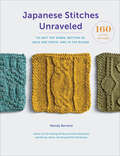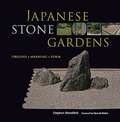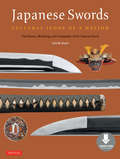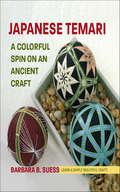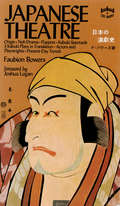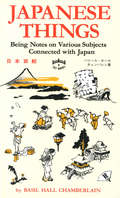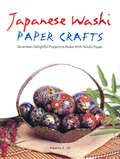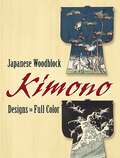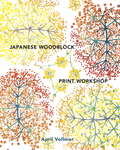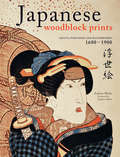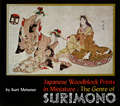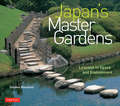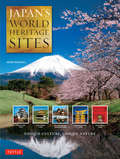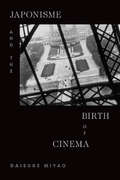- Table View
- List View
Japanese Stitches Unraveled: 160+ Stitch Patterns to Knit Top Down, Bottom Up, Back and Forth, and In the Round (Stitch Dictionary Ser.)
by Wendy BernardJapanese stitch patterns are eye-catching and much sought after by devotees, but before now, they often seemed out of reach, whether locked behind Japanese-only instructions or tangled up in difficult-to-decipher illustrations. Japanese Stitches Unraveled offers 150 rare patterns inspired by these elusive and intricate Japanese stitch designs, along with fully illustrated charts, familiar symbols, and clear instructions for every single stitch. Each stitch pattern receives Bernard’s unique four-direction makeover—topdown, bottom-up, back-and-forth, and in-the-round. To showcase the knitting in action, Bernard also includes instructions for six garments as well as her famous formulas for knitting without a pattern.
Japanese Stone Gardens
by Stephen Mansfield Donald RichieThe Japanese stone garden is an art form recognized around the globe. These gardens provide tranquil settings where visitors can shed the burdens and stresses of modern existence, satisfy an age-old yearning for solitude and repose, and experience the restorative power of art and nature. For this reason the value of the Japanese stone garden today is arguably even greater than when many of them were created.Japanese Stone Gardens provides a comprehensive introduction to the powerful mystique and dynamism of the Japanese stone garden--from their earliest use as props in animistic rituals, to their appropriation by Zen monks and priests to create settings conducive to contemplation and finally to their contemporary uses and meaning. With insightful text and abundant imagery, this book reveals the hidden order of stone gardens and in the process heightens the enthusiast's appreciation of them.
Japanese Swords
by Colin M. Roach"Tracks the fundamental transition from the sword as a mythological instrument to a functional tool for war, and finally to the display art commodity it is today. " - Publishers WeeklyAuthor Colin M. Roach collaborated with top-level artisans, historians, and martial arts experts to create a unique, in-depth study of these magnificent weapons from a historical, iconographical, and technological perspective. In addition to a foreword by seventh degree iaido black belt Nicklaus Suino and a sidebar by Mukansa-level polisher Abe Kazunori, Japanese Swords includes rare looks into the world of Mukansa-level swordsmiths Kawachi Kunihira and Gassan Sadatoshi. Complemented by hundreds of stunning high-resolution photos and a DVD, Japanese Swords is a must-have addition to any Japanophile's library.
Japanese Swords
by Colin M. Roach"Tracks the fundamental transition from the sword as a mythological instrument to a functional tool for war, and finally to the display art commodity it is today. " - Publishers Weekly Author Colin M. Roach collaborated with top-level artisans, historians, and martial arts experts to create a unique, in-depth study of these magnificent weapons from a historical, iconographical, and technological perspective. In addition to a foreword by seventh degree iaido black belt Nicklaus Suino and a sidebar by Mukansa-level polisher Abe Kazunori, Japanese Swords includes rare looks into the world of Mukansa-level swordsmiths Kawachi Kunihira and Gassan Sadatoshi. Complemented by hundreds of stunning high-resolution photos and downloadable material, Japanese Swords is a must-have addition to any Japanophile's library.
Japanese Swords
by Colin M. Roach Nicklaus Suino"Tracks the fundamental transition from the sword as a mythological instrument to a functional tool for war, and finally to the display art commodity it is today." - Publishers WeeklyAuthor Colin M. Roach collaborated with top-level artisans, historians, and martial arts experts to create a unique, in-depth study of these magnificent weapons from a historical, iconographical, and technological perspective. In addition to a foreword by seventh degree iaido black belt Nicklaus Suino and a sidebar by Mukansa-level polisher Abe Kazunori, Japanese Swords includes rare looks into the world of Mukansa-level swordsmiths Kawachi Kunihira and Gassan Sadatoshi. Complemented by hundreds of stunning high-resolution photos and downloadable material, Japanese Swords is a must-have addition to any Japanophile's library.
Japanese Tattoos: History * Culture * Design
by Brian Ashcraft Hori BennyThinking of getting a Japanese-style tattoo? Want to avoid a permanent mistake? Japanese Tattoos is an insider's look at the world of Japanese irezumi (tattoos).Japanese Tattoos explains the imagery featured in Japanese tattoos so that readers can avoid getting ink they don't understand or, worse, that they'll regret. This photo-heavy book will also trace the history of Japanese tattooing, putting the iconography and kanji symbols in their proper context so readers will be better informed as to what they mean and have a deeper understanding of irezumi. Tattoos featured will range from traditional tebori (hand-poked) and kanji tattoos to anime-inspired and modern works-as well as everything in between. For the first time, Japanese tattooing will be put together in a visually attractive, informative, and authoritative way.Along with the 350+ photos of tattoos, Japanese Tattoos will also feature interviews with Japanese tattoo artists on a variety of topics. What's more, there will be interviews with clients, who are typically overlooked in similar books, allowing them to discuss what their Japanese tattoos mean to them. Those who read this informative tattoo guide will be more knowledgeable about Japanese tattoos.
Japanese Temari: A Colorful Spin on an Ancient Craft
by Barbara B. SuessWith little more than a needle and colorful embroidery threads, Barbara Suess shows how to make beautiful Japanese temari—a folk craft dating back to the to the 12th century. Crafted from the same silk threads used to weave elegant kimonos, temari balls evolved from playthings for children to an exquisite art form that delights all ages. Traditional temari incorporates centuries-old beloved patterns embroidered onto a simple handball. In Japanese Temari, Barbara Suess shares the secrets of making temari balls passed down through generations. Showcased in beautiful color photographs are 24 designs, starting with a simple pattern that can be completed in an hour or less. For every design, color drawings show exactly what to do. Each design introduces a new level of skill, allowing you to build your temari repertoire as you work through the book. Made as gifts or as elegant home decorations, every temari completed will add light and delight to any decor. Suess has thoughtfully included inspirational watercolor drawings and haiku poetry that invite you further inside Japan’s unique artistic traditions. Japanese Temari features: - 24 beautifully embroidered temari designs - Complete, step-by-step directions and easy- to-follow color drawings - A “ball prep” primer - At-a-glance stitch guides for right and left-handed stitchers - An illustrated glossary, plus a guide for temari teachers Barbara Suess’s Japanese Temari will give you hours of pleasure as you create objects of delight to have and to give!
Japanese Theatre
by Faubion Bowers Joshua LoganJapanese Theatre, by Faubion Bowers, presents a full historical account for Westerners of the theatre arts that have flourished for centuries in Japan. "This book," say Mr. Bowers, "is a survey of what theatre arts exist there today and how they arose. Because Kabuki is the dominant type of drama in Japan today, and has been for three centuries, I have given most attention to it."This book, with its many excellent photographs, is a permanent addition to the West's knowledge of the exotic, exciting theatre of Japan and its tradition of great acting.
Japanese Things
by Basil Hall ChamberlainArmchair travelers beware!Japanese Things will lure you out of your cozy, comfy home and chair to an unusual country with bewitching manners and customs-and once you have succumbed to its spell you will never be the same. Here in one neat package you will meet the flavor, charm, and piquancy of old Japan-a revised reprint of one of the indispensable books on Japan, by the late Prof. Basil Hall Chamberlain,eminent British scholar who in the latter part of the 19th century "taught Japanese and Japan to the Japanese." Many books in one, this monumental compilation contains such diversified subjects as Art and Abacus; Botany and Buddhism; Charms and Cherry Blossoms; Daimyos and Divination; Fairy Tales and Flowers; Gardens and Government; History and Hara-kiri; Law and Language; Marriage and Music; Poetry and Pottery; Shinto and Singing Girls (Geisha); Tea and Theater, and Writing and Wood Engraving. In this long-awaited reprint, in which the title has been changed from Things Japanese, the reader will encounter exquisite objects of daily Japanese life, the gardens and cultures of the fields, the harmony and balance in the fundamentals of day-by-day existence.
Japanese Things
by Basil Hall ChamberlainArmchair travelers beware!Japanese Things will lure you out of your cozy, comfy home and chair to an unusual country with bewitching manners and customs-and once you have succumbed to its spell you will never be the same. Here in one neat package you will meet the flavor, charm, and piquancy of old Japan-a revised reprint of one of the indispensable books on Japan, by the late Prof. Basil Hall Chamberlain,eminent British scholar who in the latter part of the 19th century "taught Japanese and Japan to the Japanese." Many books in one, this monumental compilation contains such diversified subjects as Art and Abacus; Botany and Buddhism; Charms and Cherry Blossoms; Daimyos and Divination; Fairy Tales and Flowers; Gardens and Government; History and Hara-kiri; Law and Language; Marriage and Music; Poetry and Pottery; Shinto and Singing Girls (Geisha); Tea and Theater, and Writing and Wood Engraving. In this long-awaited reprint, in which the title has been changed from Things Japanese, the reader will encounter exquisite objects of daily Japanese life, the gardens and cultures of the fields, the harmony and balance in the fundamentals of day-by-day existence.
Japanese Things
by Basil Hall ChamberlainArmchair travelers beware!Japanese Things will lure you out of your cozy, comfy home and chair to an unusual country with bewitching manners and customs-and once you have succumbed to its spell you will never be the same. Here in one neat package you will meet the flavor, charm, and piquancy of old Japan-a revised reprint of one of the indispensable books on Japan, by the late Prof. Basil Hall Chamberlain,eminent British scholar who in the latter part of the 19th century "taught Japanese and Japan to the Japanese." Many books in one, this monumental compilation contains such diversified subjects as Art and Abacus; Botany and Buddhism; Charms and Cherry Blossoms; Daimyos and Divination; Fairy Tales and Flowers; Gardens and Government; History and Hara-kiri; Law and Language; Marriage and Music; Poetry and Pottery; Shinto and Singing Girls (Geisha); Tea and Theater, and Writing and Wood Engraving. In this long-awaited reprint, in which the title has been changed from Things Japanese, the reader will encounter exquisite objects of daily Japanese life, the gardens and cultures of the fields, the harmony and balance in the fundamentals of day-by-day existence.
Japanese Washi Paper Crafts
by Robertta A. UhlIn Japan, paper and paper crafts are held in popular esteem. The originators of origami, the art of paper-folding, and kirigami, the art of paper-cutting, the Japanese also make their own paper, called washi. A colorful printed paper, washi is used to decorate everything from boxes to dolls. Noted for its strength, durability and flexibility, washi paper is available in a rich array of colors, textures, weights and patterns.Japanese Washi Paper Crafts is a selection of seventeen designs for decorating commonly available objects, such as milk cartons, boxes and eggs, which can be used in home decor, as gifts, or for special occasions. Every project is shown with clear, step-by-step diagrams. Color photographs show completed projects, as well as imaginative ways for displaying the finished crafts.
Japanese Washi Paper Crafts
by Robertta A. UhlIn Japan, paper and paper crafts are held in popular esteem. The originators of origami, the art of paper-folding, and kirigami, the art of paper-cutting, the Japanese also make their own paper, called washi. A colorful printed paper, washi is used to decorate everything from boxes to dolls. Noted for its strength, durability and flexibility, washi paper is available in a rich array of colors, textures, weights and patterns.Japanese Washi Paper Crafts is a selection of seventeen designs for decorating commonly available objects, such as milk cartons, boxes and eggs, which can be used in home decor, as gifts, or for special occasions. Every project is shown with clear, step-by-step diagrams. Color photographs show completed projects, as well as imaginative ways for displaying the finished crafts.
Japanese Woodblock Flower Prints
by Tanigami KônanExceptionally drawn in a realistic fashion and awash in spectacularly rich colors, this one-of-a-kind art book -- masterfully reprinted from a rare and costly edition -- combines the perennial appeal of flowers with the art of Japanese woodblock prints.Nothing expresses the richness and vigor of life like blooming flowers. A stunning showcase of 120 full-color plates, this specially chosen collection features beautiful Eastern and Western botanicals that will delight flower lovers, artists, designers, and devotees of fine art. Admire such familiar and unusual blossoms as the poppy, rose, anemone, cyclamen, delphinium, water lily, lupine, passion flower, allamanda, phlox, dahlia, petunia, tulip, freesia, pansy, begonia, and many more beautiful blooms!Tanigami Kônan (1879-1928) was a genius at the art of woodblock creation and color gradation, and he is still celebrated as one of the finest artists of this highly specialized technique. Captions and a complete index are included in this distinct keepsake edition.
Japanese Woodblock Kimono Designs in Full Color
by DoverThe delicate beauty of the kimono and its appealing designs embody Japan's ancient and venerable tradition of textile arts. This unusual design treasury recaptures the graceful art of the kimono in all its subtle elegance, with authentic designs from a nineteenth-century source.Reproduced directly from a rare and costly original portfolio, these luminous designs include allover patterns, nature scenes, magnificent floral sprays, and other finely detailed motifs. Sixty-two lavish full-color illustrations offer a vibrant resource of inspiration and browsing pleasure to devotees of fashion, art, and Asian culture.
Japanese Woodblock Print Workshop
by April VollmerAn inspirational how-to course on Japanese woodblock printing's history and techniques, with guidance on materials and studio practices, step-by-step demonstrations, and examples of finished works by modern masters of the medium as well as historic pieces. A Modern Guide to the Ancient Art of mokuhanga An increasingly popular yet age-old art form, Japanese woodblock printing (mokuhanga) is embraced for its non-toxic character, use of handmade materials, and easy integration with other printmaking techniques. In this comprehensive guide, artist and printmaker April Vollmer--one of the best known mokuhanga practitioners and instructors in the West--combines her deep knowledge of this historic printmaking practice with expert step-by-step instruction, guidance on materials and studio practices, and a diverse collection of prints by leading contemporary artists. At once practical and inspirational, this handbook is as useful to serious printmakers and artists as it is to creative people drawn to Japanese history and aesthetics.From the Hardcover edition.
Japanese Woodblock Prints
by Stephen Addiss Andreas MarksJapanese woodblock prints, or ukiyo-e, are the most recognizable Japanese art form. Their massive popularity has spread from Japan to be embraced by a worldwide audience. Covering the period from the beginning of the Japanese woodblock print in the 1680s until the year 1900, Japanese Woodblock Prints provides a detailed survey of all the major artists, along with the images on which their fame rests.Unlike previous examinations of this art form, Japanese Woodblock Prints includes detailed histories of the publishers of woodblock prints--who were often the driving force determining which prints, and therefore which artists, would make it into mass circulation for a chance at critical and popular success. Invaluable as a guide for ukiyo-e enthusiasts looking for detailed information about their favorite artists and prints, it is also an ideal introduction for newcomers to the world of the woodblock print. This lavishly illustrated book will be a valued addition to the libraries of scholars, as well as the general art enthusiast.
Japanese Woodblock Prints
by Andreas Marks Stephen AddissJapanese woodblock prints, or ukiyo-e, are the most recognizable Japanese art form. Their massive popularity has spread from Japan to be embraced by a worldwide audience. Covering the period from the beginning of the Japanese woodblock print in the 1680s until the year 1900, Japanese Woodblock Prints provides a detailed survey of all the major artists, along with the images on which their fame rests.Unlike previous examinations of this art form, Japanese Woodblock Prints includes detailed histories of the publishers of woodblock prints--who were often the driving force determining which prints, and therefore which artists, would make it into mass circulation for a chance at critical and popular success. Invaluable as a guide for ukiyo-e enthusiasts looking for detailed information about their favorite artists and prints, it is also an ideal introduction for newcomers to the world of the woodblock print. This lavishly illustrated book will be a valued addition to the libraries of scholars, as well as the general art enthusiast.
Japanese Woodblock Prints in Miniature: The Genre of Surimono
by Kurt MeissnerThis beautifully illustrated book, a collector's item, is based on the author's private collection of more than sixty years. It is a unique introduction to the background and aesthetic appreciation of the rare and elegant art form. Included in the pages are notes on technique, terminology, surimono collecting and commissioning, as well as biographies of known surimono artists, and a detailed list of surimono catalogs and exhibitions. The text is supplemented by 33 color plates, Index Glossary, and Annotated Bibliography.
Japanese Woodblock Prints in Miniature: The Genre of Surimono
by Kurt MeissnerThis beautifully illustrated book, a collector's item, is based on the author's private collection of more than sixty years. It is a unique introduction to the background and aesthetic appreciation of the rare and elegant art form. Included in the pages are notes on technique, terminology, surimono collecting and commissioning, as well as biographies of known surimono artists, and a detailed list of surimono catalogs and exhibitions. The text is supplemented by 33 color plates, Index Glossary, and Annotated Bibliography.
Japan's Master Gardens
by Stephen MansfieldNo two Japanese gardens are ever the same. Each is inimitable, yet embodies commonalities of design and aesthetic taste. Each finds the space for innovation within a tradition that benefits from a thousand years of applied knowledge. Presenting twenty-five master gardens, Japan's Master Gardens explores the ingenuity and range of Japanese landscaping, from the self-imposed confines of courtyard designs to the open expanses of the stroll garden.Japan's Master Gardens illustrates how, through the ministrations of generations of gardeners, original landscapes have maintained their mastery and demonstrates how contemporary landscaping draws from tradition, making ancient gardens relevant to the lives of people in the twenty-first century.This beautifully illustrated book takes readers on an exploration of the outward forms, underpinning principles, complex use of metaphor and allusion, and beauty and depth that set the Japanese garden apart.
Japan's World Heritage Sites
by John DougillVisit the most compelling cultural and nature sites in all of Japan!In Japan's World Heritage Sites, readers are introduced to the temples, gardens, castles and natural wonders for which Japan is so justly renowned-all of those now declared to be UNESCO World Heritage Sites. Author John Dougill describes each site in detail, stating why they were singled out by UNESCO, the current number and types of sites, the application process, how the sites have been selected, and how difficult it is to be given the special status of a World Heritage Site.Dougill traveled to all of the sites in Japan to research this book. These are without a doubt the most interesting sites that Japan has to offer, including: Mount Fuji, Japan's tallest and most sacred volcano. Himeji Castle, a monument from Japan's long feudal history. Horyu-ji Temple, the world's oldest surviving wooden structure Hiroshima Peace Memorial or Atomic-Bomb Dome The Ogasawara Islands, a remote archipelago of over 30 islands-including Iwo JimaReaders will learn how Japan first became involved with the World Heritage Sites program back in 1993, the importance of these designations, and their popularity in Japan, where they are visited by millions of people annually.
Japonisme and the Birth of Cinema
by Daisuke MiyaoIn Japonisme and the Birth of Cinema, Daisuke Miyao explores the influence of Japanese art on the development of early cinematic visual style, particularly the actualité films made by the Lumière brothers between 1895 and 1905. Examining nearly 1,500 Lumière films, Miyao contends that more than being documents of everyday life, they provided a medium for experimenting with aesthetic and cinematic styles imported from Japan. Miyao further analyzes the Lumière films produced in Japan as a negotiation between French Orientalism and Japanese aesthetics. The Lumière films, Miyao shows, are best understood within a media ecology of photography, painting, and cinema, all indebted to the compositional principles of Japonisme and the new ideas of kinetic realism it inspired. The Lumière brothers and their cinematographers shared the contemporaneous obsession among Impressionist and Post-Impressionist artists about how to instantly and physically capture the movements of living things in the world. Their engagement with Japonisme, he concludes, constituted a rich and productive two-way conversation between East and West.
Jarrell
by Priscilla S. King Mary H. HodgeIn 1909, real estate developer Orlando D. Jarrell had a vision: He would sell lots near the Bartlett Western Railroad site and name the town Jarrell. When the railroad bypassed the nearby town of Corn Hill and Jarrell's lots began to sell, the residents of Corn Hill--and their houses--moved to the promising, new town. Rock quarries became and are still a mainstay of this area, shipping limestone all over the world. About 200 vintage photographs illustrate the time between 1855 and more recent years, including the monstrous 1997 tornado that put Jarrell into the national spotlight.
Jasmin Vardimon's Dance Theatre: Movement, memory and metaphor
by Jasmin Vardimon Libby WorthJasmin Vardimon’s Dance Theatre offers an unusual, intimate insight into the devising and training processes of a choreographer in the midst of her practice. Libby Worth and Jasmin Vardimon take a collaborative approach to recording and exploring the working processes of Vardimon and her company, chronicling the development of specific productions rather than offering a single choreographic blueprint. Focusing on the techniques, strategies and creative activities necessitated by each project, Worth and Vardimon address: The initial ‘triggers’ which lead to research, expansion, and performance; The social, political and psychological content of Vardimon’s work; The relationship between accessibility of content and complexity of ideas; Drawing on texts to enhance and shape a piece of dance work; The editing process, and its inherent messiness; The contribution of a company’s different voices and viewpoints to the development of a production. Based on extended conversations and interviews, this highly illustrated, full -colour volume is a unique reflection on Jasmin Vardimon’s vibrant, continually developing practice. It is a must-read for students and practitioners of dance and physical theatre.
